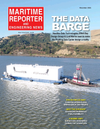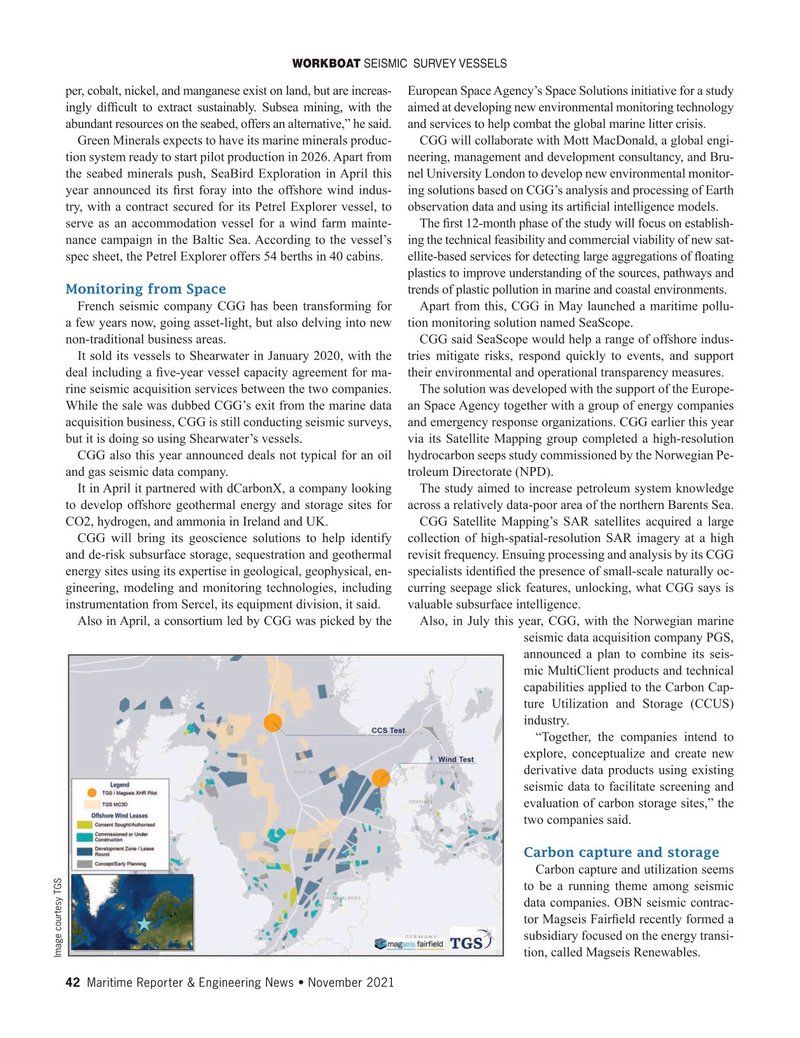
Page 42: of Maritime Reporter Magazine (November 2021)
The Workboat Edition
Read this page in Pdf, Flash or Html5 edition of November 2021 Maritime Reporter Magazine
WORKBOAT SEISMIC SURVEY VESSELS per, cobalt, nickel, and manganese exist on land, but are increas- European Space Agency’s Space Solutions initiative for a study ingly dif? cult to extract sustainably. Subsea mining, with the aimed at developing new environmental monitoring technology abundant resources on the seabed, offers an alternative,” he said. and services to help combat the global marine litter crisis.
Green Minerals expects to have its marine minerals produc- CGG will collaborate with Mott MacDonald, a global engi- tion system ready to start pilot production in 2026. Apart from neering, management and development consultancy, and Bru- the seabed minerals push, SeaBird Exploration in April this nel University London to develop new environmental monitor- year announced its ? rst foray into the offshore wind indus- ing solutions based on CGG’s analysis and processing of Earth try, with a contract secured for its Petrel Explorer vessel, to observation data and using its arti? cial intelligence models. serve as an accommodation vessel for a wind farm mainte- The ? rst 12-month phase of the study will focus on establish- nance campaign in the Baltic Sea. According to the vessel’s ing the technical feasibility and commercial viability of new sat- spec sheet, the Petrel Explorer offers 54 berths in 40 cabins. ellite-based services for detecting large aggregations of ? oating plastics to improve understanding of the sources, pathways and
Monitoring from Space trends of plastic pollution in marine and coastal environments.
French seismic company CGG has been transforming for Apart from this, CGG in May launched a maritime pollu- a few years now, going asset-light, but also delving into new tion monitoring solution named SeaScope.
non-traditional business areas. CGG said SeaScope would help a range of offshore indus-
It sold its vessels to Shearwater in January 2020, with the tries mitigate risks, respond quickly to events, and support deal including a ? ve-year vessel capacity agreement for ma- their environmental and operational transparency measures.
rine seismic acquisition services between the two companies. The solution was developed with the support of the Europe-
While the sale was dubbed CGG’s exit from the marine data an Space Agency together with a group of energy companies acquisition business, CGG is still conducting seismic surveys, and emergency response organizations. CGG earlier this year but it is doing so using Shearwater’s vessels. via its Satellite Mapping group completed a high-resolution
CGG also this year announced deals not typical for an oil hydrocarbon seeps study commissioned by the Norwegian Pe- and gas seismic data company. troleum Directorate (NPD).
It in April it partnered with dCarbonX, a company looking The study aimed to increase petroleum system knowledge to develop offshore geothermal energy and storage sites for across a relatively data-poor area of the northern Barents Sea.
CO2, hydrogen, and ammonia in Ireland and UK. CGG Satellite Mapping’s SAR satellites acquired a large
CGG will bring its geoscience solutions to help identify collection of high-spatial-resolution SAR imagery at a high and de-risk subsurface storage, sequestration and geothermal revisit frequency. Ensuing processing and analysis by its CGG energy sites using its expertise in geological, geophysical, en- specialists identi? ed the presence of small-scale naturally oc- gineering, modeling and monitoring technologies, including curring seepage slick features, unlocking, what CGG says is instrumentation from Sercel, its equipment division, it said. valuable subsurface intelligence.
Also in April, a consortium led by CGG was picked by the Also, in July this year, CGG, with the Norwegian marine seismic data acquisition company PGS, announced a plan to combine its seis- mic MultiClient products and technical capabilities applied to the Carbon Cap- ture Utilization and Storage (CCUS) industry.
“Together, the companies intend to explore, conceptualize and create new derivative data products using existing seismic data to facilitate screening and evaluation of carbon storage sites,” the two companies said.
Carbon capture and storage
Carbon capture and utilization seems to be a running theme among seismic data companies. OBN seismic contrac- tor Magseis Fair? eld recently formed a subsidiary focused on the energy transi- tion, called Magseis Renewables.
Image courtesy TGS 42 Maritime Reporter & Engineering News • November 2021
MR #11 (34-49).indd 42 11/4/2021 10:43:13 AM

 41
41

 43
43
